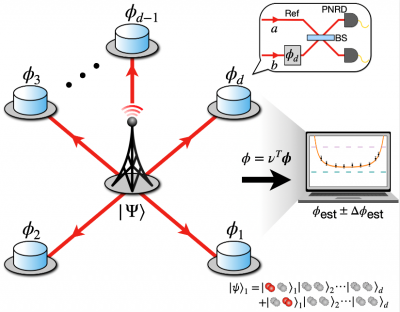Science
KIST Unveils Groundbreaking Quantum Sensor Network Using Entangled Light

A research team led by Dr. Hyang-Tag Lim at the Korea Institute of Science and Technology (KIST) has achieved a significant breakthrough in quantum technology. They have developed the world’s first ultra-high-resolution distributed quantum sensor network that leverages a unique quantum-entangled state known as the multi-mode N00N state. This innovative approach allows for remarkable improvements in both precision and resolution across multiple sensors simultaneously.
The advancement represents a pivotal moment in the field of quantum sensing. By utilizing the properties of entangled light, the team at the Center for Quantum Technology at KIST demonstrated that it is possible to enhance the performance of distributed sensors, which are crucial for applications ranging from environmental monitoring to medical diagnostics.
This newly demonstrated technology enables various sensors to work in tandem, sharing quantum information to achieve levels of accuracy previously deemed unattainable. The implications of this development could extend widely, potentially transforming industries that rely on precise measurements and real-time data collection.
Quantum sensors have been gaining attention for their ability to detect minute changes in physical parameters, such as gravity and magnetic fields. The introduction of the multi-mode N00N state into this realm marks a significant leap forward. According to the research conducted at KIST, the network can perform measurements with enhanced sensitivity, which could lead to breakthroughs in scientific research and practical applications.
As the research team continues to refine this technology, the potential for commercialization is becoming more apparent. Experts believe that the integration of such advanced quantum sensors could revolutionize sectors like telecommunications and navigation. The ability to achieve ultra-high-resolution sensing means that data collection will not only be faster but also more reliable.
In summary, the work by Dr. Hyang-Tag Lim and his team at KIST positions South Korea at the forefront of quantum technology research. Their innovative use of entangled light to create a distributed quantum sensor network is a testament to the power of collaboration in scientific advancement. As further developments occur, the impact of this research will likely extend well beyond the laboratory, influencing various aspects of modern technology and industry.
-

 Lifestyle3 months ago
Lifestyle3 months agoLibraries Challenge Rising E-Book Costs Amid Growing Demand
-

 Sports3 months ago
Sports3 months agoTyreek Hill Responds to Tua Tagovailoa’s Comments on Team Dynamics
-

 Sports3 months ago
Sports3 months agoLiverpool Secures Agreement to Sign Young Striker Will Wright
-

 Lifestyle3 months ago
Lifestyle3 months agoSave Your Split Tomatoes: Expert Tips for Gardeners
-

 Lifestyle3 months ago
Lifestyle3 months agoPrincess Beatrice’s Daughter Athena Joins Siblings at London Parade
-

 World3 months ago
World3 months agoWinter Storms Lash New South Wales with Snow, Flood Risks
-

 Science3 months ago
Science3 months agoTrump Administration Moves to Repeal Key Climate Regulation
-

 Business3 months ago
Business3 months agoSoFi Technologies Shares Slip 2% Following Insider Stock Sale
-

 Science2 months ago
Science2 months agoSan Francisco Hosts Unique Contest to Identify “Performative Males”
-

 Science3 months ago
Science3 months agoNew Tool Reveals Link Between Horse Coat Condition and Parasites
-

 Sports3 months ago
Sports3 months agoElon Musk Sculpture Travels From Utah to Yosemite National Park
-

 Science3 months ago
Science3 months agoNew Study Confirms Humans Transported Stonehenge Bluestones








